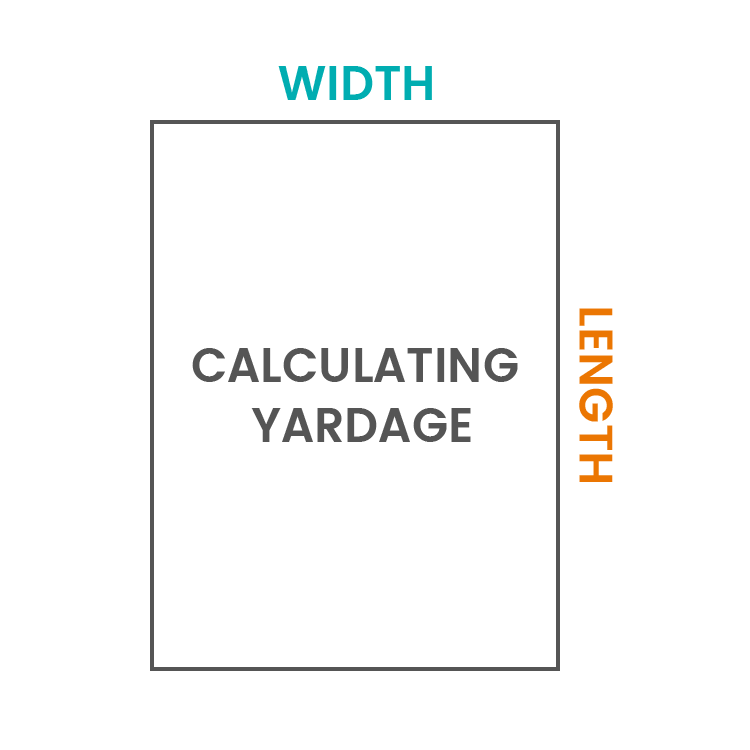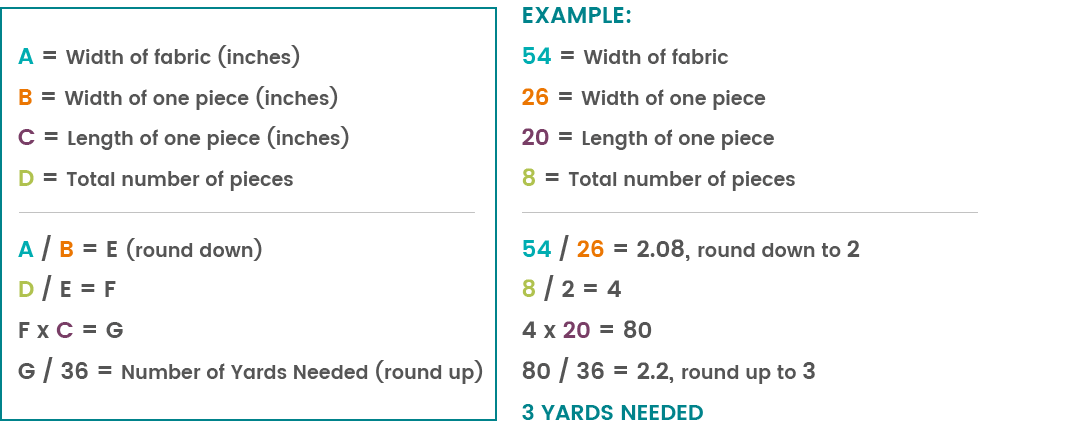How Much Deco Art Triple Thick Do I Need for a 70 X 40 Canvas
Calculating Fabric Yardage for Your Projection
- Past OnlineFabricStore
These instructions volition show you how to calculate how many yards y'all need for several different scenarios, whether your dimensions are larger or smaller than the width of your desired cloth.
These calculations work for many projects, including pillows, cushions, cloth wallpaper, tablecloths, bedding, and headboards.
For more specific types of projects, see these other resource:
- Curtains – Nosotros advise using our drapery yardage calculator.
- Sofa & Chair Upholstery – See our upholstery charts for yardage estimates.
- Tablecloths – Meet Measuring Yardage for a Tablecloth for additional information specific to tablecloths.

Total Dimensions
i thou = three anxiety = 36 inches
For the balance of the world on the metric system, catechumen to inches before starting. The easiest way to practise this is to google "cm to inches" and enter the centimeters into the conversion estimator.
First, you need to know what the full dimensions are in inches. This includes whatsoever extra you need to sew, apply, or cease the fabric.
For example:
- If you're making something that needs a seam allowance, similar pillows, you need to add together the seam allowance times 2 to the width and length.
- If yous're making canvas wall fine art, yous need to know the size of the canvas plus how much extra is needed to wrap around the back and staple. Same idea for reupholstering dining chairs.
- If you're making something that needs to exist hemmed, yous need to know how much extra you need for the hems.
The other affair you need to know is how wide your desired fabric is.
Move onto the next steps according to if your total dimensions will fit into the width of the fabric or not.
Dimensions that fit into the width of the fabric
One slice
If you lot just need one piece of fabric and information technology fits into the width of your fabric, you probably don't fifty-fifty demand to exist reading this, simply nosotros'll explain just in instance!
Take the total length you need and split up by 36 to calculate how many yards you demand. Most of our fabric is sold in full 1000 increments, so circular upward to the nearest yard.
Multiple pieces
If yous need multiple pieces that are the same size, similar for pillows, napkins, dining room chair upholstery, etc., start with your fabric width and divide by the width of one of the pieces you need.
Circular down to the nearest whole number. This is how many pieces fit into the width.
Next have the total number of pieces and dissever by this number to figure out how many rows you volition need.
Finally accept the length of a unmarried piece and multiply that past the number of rows. Separate by 36 and circular up to the nearest whole number.

If your fabric is solid or non directional, y'all can try flipping the width and length to see that needs fewer yards. In the example, in one case rounded up, it is as well iii yards.
If you demand multiple sizes, it helps to draw it out.
Dimensions that are wider than the width of the fabric
When the width of the piece is wider than the width of the textile, you'll need to run up or join pieces together.
These calculations work for many projects, including textile wallpaper and other wall coverings, tablecloths, duvet covers and bedding, ground and floor coverings, awnings, banners, backdrops, headboards, and panels.
One piece
Start with your desired total width and divide by the width of the cloth. Round upwardly to the next whole number. This is how many widths of fabric you need.
Then take the total desired length and multiply past the number of widths y'all only calculated.
Divide past 36 and round up to the next whole number. This is the total yardage y'all need.

Multiple pieces
If you need multiple pieces that are the same size, before dividing by 36, multiply by the number you demand, then split up by 36 and round upwards.
Or if they're different sizes, add together them upward before dividing by 36.
Patterned Fabrics
If you have a patterned fabric and want to match upwardly the blueprint, before dividing past 36, add together one vertical echo per every extra width of cloth.
For example, if you need 3 widths of material to get the correct total width, add 2 times the vertical repeat to the total length earlier dividing by 36.
If the length is less than the vertical repeat, just utilise the vertical repeat every bit the length and you lot don't accept to add together extra before converting to yards.
You lot can find the repeats in the details section on the product page for our fabrics. Most of the time you lot don't have to worry almost the horizontal echo because the blueprint will divide evenly into the width of the cloth. This means the pattern will match up at the selvages with a slight overlap then no fabric is wasted.
Placing seams
Some projects, similar duvets, tablecloths, and headboards, look all-time if you have the full width slice in the center and the remainder on the sides. This looks more than professional person than having a seam correct downwardly the middle.
To find out how to sew patterned fabric together, look at How To Make a Duvet Cover.
Please Note: We're unable to answer your questions about specific projects in a timely manner hither so please contact our customer service if you need additional help. You need to know the width of the fabric you want in guild for us to give you accurate data.
These instructions are good for rectangular pieces and tin be used with other shapes if you lot measure the dimensions at the largest width and length. Some projects tin be likewise complicated and yous may accept to estimate. It'southward better to end up with too much than to come short!
Notice the fabric for your projection here!
Source: https://www.onlinefabricstore.com/makersmill/calculating-fabric-yardage-for-your-project/
0 Response to "How Much Deco Art Triple Thick Do I Need for a 70 X 40 Canvas"
Post a Comment